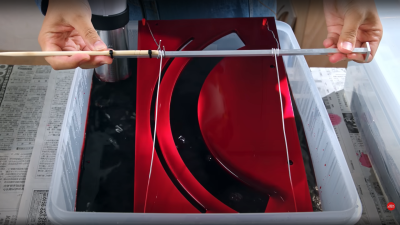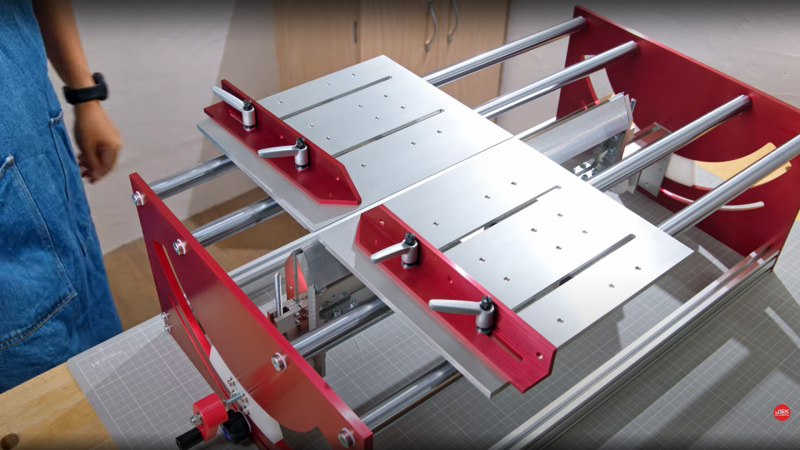[JSK-koubou] has quite the talent for creative woodwork, particularly building interesting tools or improving existing ones. This recent project (multiple build videos below: part 1, part 2, and part 3) is a very flexible type of guided pull saw, whereby a fine-toothed saw blade is fixed in the bed, and the workpiece is pulled over it it. By fixing it at a shallow angle, and enabling the blade to be raised up through the bed, the workpiece can be progressively cut by simply pulling it over the blade, then winding it up a little until the final cut length is achieved.
From a construction perspective, the tool is all-metal, built from a collection of the off-the-shelf parts, and thick, hand-cut aluminium alloy plate, nary a CNC tool in sight. The only unusual component is the saw blade itself, which might be a bit tricky to track down if you were so inclined to reproduce the build. It appears (well if you believe the auto-translation by Google Lens, anyway) to be a spare blade for a commercial guide saw available in Japan at least.
which might be a bit tricky to track down if you were so inclined to reproduce the build. It appears (well if you believe the auto-translation by Google Lens, anyway) to be a spare blade for a commercial guide saw available in Japan at least.
We found it particularly pleasing to see the use of a home-built anodizing setup to give it a bit of a jazzy color scheme for some of the plates, just because. Like with many of the build videos from this YouTuber, it is well worth watching all of them, if only just to gather a few ideas for one’s own workspace, if you can stop yourself getting distracted looking at all the other neat tools he uses on the way.
DIY tool builds are not uncommon in these parts, here’s a neat DIY combo table-based project, and here’s a homebrew auto-lowering metal bandsaw which could be a real timesaver.















It’s a beautiful build, but let’s be clear, this isn’t a creative design, it’s a faithful clone of a commercially available tool, the Bridge City Jointmaker Pro (JMP).
Thanks, I look it up and it is a copy. But the original is also $890, so I see the attraction of builoding your own.
How much do you suppose he invested in time an materials building his copy? Nice work but financially it was probably a wash. I doubt he did it to save money.
For the vast majority of people here time spent learning to make something has no cost, in fact it is a gain when you account that the knowledge acquired along the way has great value in future projects, plus making stuff for most is half of the fun.
I suspect looking at it this is a much higher quality and more enduring build than the commercial ones, though they at a glance look good too… Even if it is more delicate that its made entirely by him means he has the tools and skill to replace the failed parts and no doubt it fits the space he has for it, which is rarely the case with the tools you can buy, always too small to be ideal or 1cm too large to fit on the shelf space available…
Actually the commercial one is like higher quality, but his mod of the blade is likely worth a lot. I forget what the custom blade cost for the original commercial unit, but it was a lot. Anyway I love his work. Also remember that while the commercial unit now costs $900, it used to cost more than twice that.
I suspect the Cease and Desist letter from Bridge City’s lawyers for patent infringement will be forthcoming soon.
I’m no lawyer, but my understanding is that you can copy a patented product for your own use. You would only be in trouble if you started making copies for sale or gift.
They have a video. That also answered my question: Why not use a circular blade, set the depth only once? Because it is quiet.
https://www.youtube.com/watch?v=3ruwZdaPjbs
Maybe a stupid question, but for the price (time and money) of that build could one not buy a decent electric miter saw. Or am I missing something?
The Jointmaker pro (JMP) is capable of far finer work than any miter saw and almost all existing jigs for table saws. (By fine I mean small and fragile). It is also much more approachable because the cutting energy is so very low and everything is really well supported.
I can say this because I have had the chance to try one at a friend’s shop. It’s impressive. So is JSK’s build. If you did kumiko or small model building it would be very tempting. Even in my inexperienced hands it was easy to achieve the repeatability for good pattern fit.
I know mini table saws that take thin small like 3 or 4 inch circular blades exist for just that purpose. I’m sure there’s miter saws as well. I always cringe a little when a fact like “it doesn’t use electricity” or lacking a motor is touted as “quiet” because I already know (generally, not all) the type of people that gravitate towards products like that. There’s a spectrum for sure but there seems to be some people that enjoy it when someone takes something that always has a motor and they remove the best part the motor and make a version that’s slower and more difficult to use because you are the motor.
I don’t really see why one couldn’t make this powered, you could even have a load cell to measure the force and adjust the raising of the blade automatically. And it could do it as slow and quiet as a person. In fact for $900 that’s how it should come, I can’t imagine how a production saw of this type (not made with the same parts, the parts in the video probably come to $900) wouldn’t be like $300 max.
All that aside this is a great high quality build, and it looks great too
These saws use a very fine kerfed blade so they work well on smaller stock. Think fine furniture and fancy boxes out of exotic woods. The blade tilt and miter fences let you do dovetails and finger joints, or repeated dado cuts. There’s a certain point on your stock size where running a miter saw is pretty dangerous. It’s pretty neat, the original is big dollars so I totally understand the urge to build one from scratch.
Yeah, what I find the most impressive in this video is the saw… it goes through oak like butter and it’s so fine too…
Japanese pull saws are quite common in woodworking, and gaining in popularity in the US. Check out Woodcraft for a wide variety of the saws and replacement blades.
I would go with an electric chop saw for sure. I have one that has a fine blade on it, it is a made in japan hatachi and it is a very well built piece. This is an amazing build no doubt but in my space I would not have space for it, it looks to be about the same footprint as a table saw. Just too big for the amount of use it would get.
They have very different uses. There’s a reason the original is called the “jointmaker” — it’s not a good tool for cutting to size, it’s a great tool for making the complex cuts needed to create tenons, dovetails, and other structures for joining pieces of wood.
It’s worth watching the video for the Bridge City Toolworks Jointmaker Pro; it does a good job of going over its purpose.
Think of it more as a super precise, ultra thin kerf table saw.
In lapidary “slab” saws from long ago (1940s-1960s)–the purpose is to cut rocks and to be able to cut very thin, smooth slices of rock–were gravity-driven pull saws. A weight and a wire cable pulled the carriage with a clamp with a rock through the blade. The speed is determined by the pulling weight and the hardness and the amount of surface contact between the rock and the cutting edge of the blade. This mechanism has been replaced by a lead screw driven by a reduction worm gear driven by a pulley and belt driven by the blade motor shaft. So new rock saws are still using the same principle, as the lead screw is pulling the rock through the blade at a very slow speed. There are other designs, including drag saws (ganged or otherwise) that are not pull saws.
TL;DR: Rotary lapidary saws are also pull saws.
This kind of saw is quieter, less dusty and safer than anything powered. You don’t need to make a jig just to keep your fingers safe. Some of us use hand tools because of this. I’m a hobby woodworker and am not making dozens of anything.
It also brings the repeatability of a table saw to hand wood working.
If I was blind, I’d be willing to try this. No way would I try most powered tools.